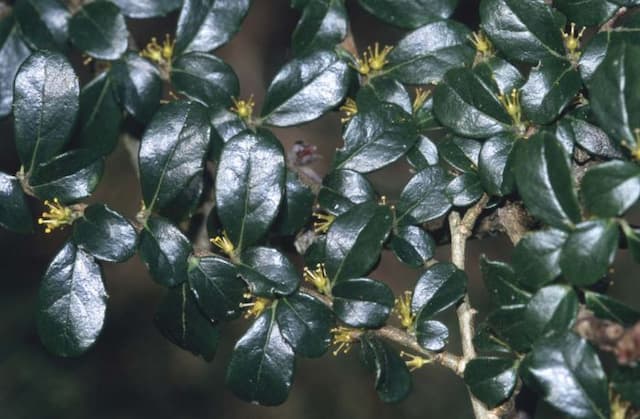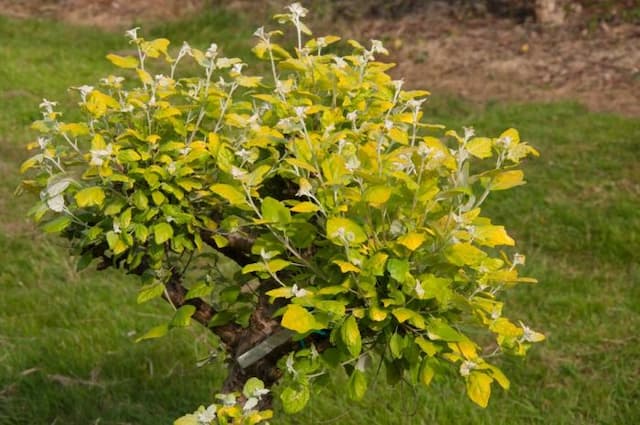Rosemary Willow Salix elaeagnos subsp. angustifolia

ABOUT
The plant commonly referred to as the narrow-leafed willow has long, slender leaves that give it a delicate, feathery appearance. The foliage displays a silvery-green hue that can shimmer beautifully in the light, contributing to its graceful aesthetic. In springtime, this plant produces flowers that develop in the form of catkins, which are elongated and often fluffy structures. These catkins can add a soft textural element to the visage of the plant. The bark of this willow might show a rough texture that contrasts with the fine, smooth quality of its leaves. During the fall, the foliage tends to turn yellow, bringing a warm color to the environment before it sheds its leaves for the winter. Overall, the appearance of the narrow-leafed willow is characterized by its elegant and narrow foliage, accompanied by distinctive catkins, all contributing to a subtle, yet sophisticated piece of the landscape.
About this plant
 Names
NamesFamily
Salicaceae
Synonyms
Rosemary Willow, Narrow-Leafed Oleaster Willow, Hoary Willow
Common names
Salix incana, Salix eleagnos angustifolia, Salix eleagnos subsp. angustifolia, Salix rosmarinifolia.
 Toxicity
ToxicityTo humans
The Salix elaeagnos subsp. angustifolia, commonly known as the rosemary willow, is not typically regarded as a toxic plant to humans. However, as with any plant material, individual allergic reactions or sensitivities are possible. If such incidents occur, the symptoms would likely resemble those of other plant allergies, which may include skin irritation, itching, or rash. Ingestion of plant material generally is not associated with severe toxicity in humans, but gastrointestinal discomfort could result from consuming large quantities due to the plant's fibrous nature.
To pets
The rosemary willow is not known to be toxic to pets. It does not contain any known toxic compounds that would cause serious harm if ingested by animals such as dogs or cats. Similar to humans, ingestion could potentially lead to mild gastrointestinal upset due to the indigestibility of the fibrous plant material. If your pet shows any signs of illness after ingesting any part of the plant, it is always best to consult with a veterinarian.
 Characteristics
CharacteristicsLife cycle
Perennials
Foliage type
Deciduous
Color of leaves
Green
Flower color
Yellow
Height
15 feet [4.6 meters]
Spread
15 feet [4.6 meters]
Plant type
Tree
Hardiness zones
5
Native area
Europe Asia
Benefits
 General Benefits
General Benefits- Ecological Stability: Salix elaeagnos subsp. angustifolia, commonly known as the rosemary willow, contributes to the stability and biodiversity of ecosystems by providing habitat and food for various wildlife species.
- Erosion Control: Because of its extensive root system, rosemary willow is effective in stabilizing soil and controlling erosion, particularly along riverbanks and wetland areas.
- Landscaping: This willow species is used in gardens and parks for ornamental purposes due to its attractive foliage and growth habit, adding aesthetic value to landscapes.
- Shelterbelt and Windbreak: Rosemary willow trees can be planted in rows to act as windbreaks, protecting crops, soil, and buildings from the damaging effects of strong winds.
- Phytoremediation: The rosemary willow has the capacity to absorb and stabilize heavy metals and other contaminants from soil and water, aiding in the cleanup of polluted environments.
- Streambank Stabilization: By planting rosemary willow along streams and rivers, it helps reinforce the banks and prevents the watercourse from changing shape due to erosion.
- Wildlife Support: It provides essential resources such as nectar, seeds, and nesting sites for birds, bees, and other fauna, thus promoting local biodiversity.
 Medical Properties
Medical PropertiesThis plant is not used for medical purposes.
 Air-purifying Qualities
Air-purifying QualitiesThis plant is not specifically known for air purifying qualities.
 Other Uses
Other Uses- The flexible branches of Salix elaeagnos subsp. angustifolia, commonly known as hoary willow, can be used in basket weaving and for crafting traditional wickerwork items.
- Hoary willow's wood is suitable for making small handcrafted items such as carved spoons or rustic ornaments due to its easy-to-work nature.
- The young twigs of the hoary willow can be used as a natural source of rooting hormone as they contain compounds that encourage root growth when placed in water alongside cuttings of other plants.
- In some regions, the branches of hoary willow are incorporated into fencing or used as supportive stakes for climbing plants in gardening.
- Farmers and gardeners sometimes plant hoary willow as a windbreak to protect crops or soil from erosion due to its fast-growing and dense branching habit.
- Because of its dense and fibrous root system, hoary willow can be used in riparian restoration projects to stabilize stream banks and prevent soil erosion.
- The catkins of the hoary willow, which are rich in pollen, serve as an early source of food for bees and other pollinators in the spring.
- The soft wood of the hoary willow is sometimes used in the production of high-quality artist charcoal, which is appreciated for its deep black hues and smooth texture.
- In landscape design, hoary willow is often planted for its ornamental value due to its slender, silvery leaves and graceful form.
- The bark of the hoary willow can be steeped to create a natural dye for textiles, producing subtle earth-toned colors.
Interesting Facts
 Feng Shui
Feng ShuiThe Rosemary Willow is not used in Feng Shui practice.
 Zodiac Sign Compitability
Zodiac Sign CompitabilityThe Rosemary Willow is not used in astrology practice.
 Plant Symbolism
Plant Symbolism- Flexibility: Salix elaeagnos subsp. angustifolia, commonly known as the Rosemary Willow, is a member of the willow family known for its flexible branches. This flexibility makes it symbolize adaptability and resilience, as the willow bends without breaking.
- Growth: Willows, including Rosemary Willow, often symbolize growth and renewal because they grow quickly and can rejuvenate from damage.
- Healing: Historically, willows have been associated with healing due to the salicylic acid found in their bark, which is a compound similar to the active ingredient in aspirin.
- Femininity: The fine, graceful foliage of the Rosemary Willow is often seen as a symbol of femininity, grace, and elegance.
- Inspiration: In some cultures, willows are seen as a source of inspiration and creativity, possibly because their rustling leaves in the breeze evoke the whispers of muses.
- Grief: Willows, including the Rosemary Willow, are commonly associated with sorrow and mourning, as their weeping form is reminiscent of tears.
 Water
WaterThe Rosemary Willow requires consistent moisture and enjoys wet or boggy conditions. It should be watered thoroughly, with the soil being allowed to become slightly dry to the touch before the next watering. As a general rule, aim to provide about 1 to 1.5 inches of water weekly, increasing the amount during dry spells or extreme heat. During the growing season, this may translate to 1-2 gallons per week for a young plant, adjusting for the plant's size and the local climate. It's essential to avoid waterlogging, which can lead to root rot, by ensuring the planting site has good drainage.
 Light
LightThe Rosemary Willow thrives in full sun to partial shade. It performs best when it receives at least six hours of direct sunlight each day, which encourages healthy growth and flowering. The ideal spot for this plant would be an open area where it is exposed to ample sunlight while receiving some afternoon shade in hotter climates.
 Temperature
TemperatureThe Rosemary Willow is hardy and can tolerate a wide temperature range, typically from around -30 to 100 degrees Fahrenheit. However, it grows best in moderate climates where temperatures are consistently between 50 and 85 degrees Fahrenheit. Extreme temperatures may damage the plant or stunt its growth, so it's important to provide a protected location if extreme cold or heat is expected.
 Pruning
PruningPruning the Rosemary Willow is beneficial to maintain its shape and encourage bushier growth. Prune in late winter or early spring before new growth begins by removing dead or damaged branches and shaping the plant as desired. It is typically sufficient to prune once a year, but you can also remove dead twigs or leaves as needed throughout the year.
 Cleaning
CleaningAs needed
 Soil
SoilThe best soil mix for Rosemary Willow (Salix elaeagnos subsp. angustifolia) should be well-draining and loamy with the ability to retain some moisture. A combination of two parts loam, one part sand, and one part compost works well. The ideal pH level for Rosemary Willow ranges from 6.5 to 7.5, slightly acidic to neutral.
 Repotting
RepottingRosemary Willow (Salix elaeagnos subsp. angustifolia) generally does not require frequent repotting and can be done every 2 to 3 years. Young plants may benefit from annual repotting while they are rapidly growing.
 Humidity & Misting
Humidity & MistingRosemary Willow (Salix elaeagnos subsp. angustifolia) prefers moderate humidity levels but is adaptable to various conditions; however, ensuring it's not too dry is beneficial for the plant's health.
 Suitable locations
Suitable locationsIndoor
Provide bright light, water when top soil feels dry for Rosemary Willow.
Outdoor
Plant in sun, well-drained soil, water regularly for Rosemary Willow.
Hardiness zone
4-8 USDA
 Life cycle
Life cycleSalix elaeagnos subsp. angustifolia, commonly known as the Rosemary Willow, begins its life cycle with seed germination, which occurs in moist soil conditions primarily along riverbanks or wetlands. After germination, the seedling emerges and grows rapidly, establishing a root system and producing elongated, narrow leaves characteristic of the willow family. As a fast-growing plant, it quickly transitions into the vegetative stage, where it develops a woody stem and branches, expanding in both height and girth. In spring, Rosemary Willow enters the reproductive phase, producing catkins which are the plant's flowers; they are usually pollinated by wind or insects. After pollination, seeds develop and disperse, often with the assistance of water, allowing the species to colonize new areas. The plant matures and can live for several years, continuing a cycle of growth and reproduction seasonally until senescence leads to eventual decline and death.
 Propogation
PropogationPropogation time
Spring
The best time to propagate Salix elaeagnos subsp. angustifolia, commonly known as rosemary willow, is typically in late winter to early spring, before the buds begin to swell. The most popular method of propagation for rosemary willow is by hardwood cuttings. These cuttings should be taken from the current year's growth, selecting woody but not yet hardened stems. Cuttings of about 6 to 9 inches (15 to 23 centimeters) in length can be made, and the lower leaves should be removed. The base of the cutting is then dipped in a rooting hormone to encourage root growth and planted in a mixture of sand and peat or a similar medium. These cuttings should be kept moist and in a sheltered environment like a cold frame or unheated greenhouse until they have rooted sufficiently, which can take several weeks. After the roots have established, the new plants can be transplanted to their final growing location.









